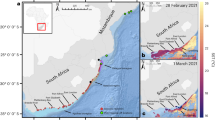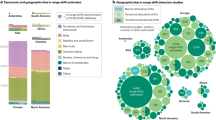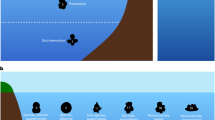Abstract
Environmental factors are important drivers of community dynamics. Yet, despite extensive research, it is still extremely challenging to predict the effect of environmental changes on the dynamics of ecological communities. Equilibrium- and model-based approaches have provided a theoretical framework with which to investigate this problem systematically. However, the applicability of this framework to empirical data has been limited because equilibrium dynamics of populations within communities are seldom observed in nature and exact equations for community dynamics are rarely known. To overcome these limitations, here we develop a data-driven non-parametric framework to estimate the tolerance of non-equilibrium community dynamics to environmental perturbations (that is, their structural stability). Following our approach, we show that in non-equilibrium systems, structural stability can vary significantly across time. As a case study, we investigate the structural stability of a rocky intertidal community with dynamics at the edge of chaos. The structural stability of the community as a whole exhibited a clear seasonal pattern, despite the persistent chaotic dynamics of individual populations. Importantly, we show that this seasonal pattern of structural stability is causally driven by sea temperature. Overall, our approach provides novel opportunities for estimating the tolerance of ecological communities to environmental changes within a non-parametric framework.
This is a preview of subscription content, access via your institution
Access options
Access Nature and 54 other Nature Portfolio journals
Get Nature+, our best-value online-access subscription
$29.99 / 30 days
cancel any time
Subscribe to this journal
Receive 12 digital issues and online access to articles
$119.00 per year
only $9.92 per issue
Buy this article
- Purchase on Springer Link
- Instant access to full article PDF
Prices may be subject to local taxes which are calculated during checkout





Similar content being viewed by others
Data availability
The data used in the manuscript can be downloaded from Benincà et al.25 (http://www.pnas.org/content/112/20/6389/tab-figures-data).
Code availability
The code accompanying the manuscript is available on GitHub at https://github.com/MITEcology/Nature.Eco.Evo-Cenci-Saavedra-2019.git. The repository contains the code used to generate Figs. 3–5 and an illustrative example of how to compute the VCR from a multivariate time series.
References
Levins, R. Evolution in Changing Environments: Some Theoretical Explorations (Monographs in Population Biology) (Princeton Univ. Press, 1968).
Thomas, C. D. et al. Extinction risk from climate change. Nature 427, 145–148 (2004).
Chase, E. & Harwood, V. J. Comparison of the effects of environmental parameters on growth rates of Vibrio vulnificus biotypes I, II, and III by culture and quantitative PCR analysis. Appl. Environ. Microbiol. 77, 4200–4207 (2011).
Montoya, J. & Raffaelli, D. Climate change, biotic interactions and ecosystem services. Phil. Trans. R. Soc. B 365, 2013–2018 (2010).
Thackeray, S. J. et al. Phenological sensitivity to climate across taxa and trophic levels. Nature 535, 241–245 (2016).
Sugihara, G. et al. Detecting causality in complex ecosystems. Science 338, 496–500 (2012).
Dai, L., Vorselen, D., Korolev, K. S. & Gore, J. Generic indicators for loss of resilience before a tipping point leading to population collapse. Science 336, 1175–1177 (2012).
Andronov, A. & Pontrjagin, L. Systémes grossiers. Dokl. Akad. Nauk SSSR 14, 247–251 (1937).
Smale, S. Differentiable dynamical systems. Bull. Am. Math. Soc. 73, 747–817 (1967).
Thom, R. Structural Stability and Morphogenesis (Addison-Wesley, 1994).
Allen, P. M. Evolution, population dynamics, and stability. Proc. Natl Acad. Sci. USA 73, 665–668 (1976).
Rohr, R. P., Saavedra, S. & Bascompte, J. On the structural stability of mutualistic systems. Science 345, 1253497 (2014).
Arnoldi, J.-F. & Haegeman, B. Unifying dynamical and structural stability of equilibria. Proc. R. Soc. Lond. A 472, 20150874 (2016).
Cenci, S. & Saavedra, S. Structural stability of nonlinear population dynamics. Phys. Rev. E 97, 012401 (2018).
Song, C., Rohr, R. P. & Saavedra, S. A guideline to study the feasibility domain of multi-trophic and changing ecological communities. J. Theor. Biol. 450, 30–36 (2018).
Wood, S. N. & Thomas, M. B. Super–sensitivity to structure in biological models. Proc. R. Soc. Lond. B 266, 565–570 (1999).
Perretti, C. T., Munch, S. B. & Sugihara, G. Model free forecasting outperforms the correct mechanistic model for simulated and experimental data. Proc. Natl Acad. Sci. USA 110, 5253–5257 (2013).
Ye, H. et al. Equation-free mechanistic ecosystem forecasting using empirical dynamic modeling. Proc. Natl Acad. Sci. USA 112, E1569–E1576 (2015).
Benincà, E. et al. Chaos in a long-term experiment with a plankton community. Nature 451, 822–825 (2008).
Bjørnstad, O. N. & Grenfell, B. T. Noisy clockwork: time series analysis of population fluctuations in animals. Science 293, 638–643 (2001).
Ushio, M. et al. Fluctuating interaction network and time-varying stability of a natural fish community. Nature 554, 360–363 (2018).
Costantino, R. F., Desharnais, R. A., Cushing, J. M. & Dennis, B. Chaotic dynamics in an insect population. Science 275, 389–391 (1997).
Turchin, P. & P. Ellner, S. Living on the edge of chaos: population dynamics of fennoscandian voles. Ecology 81, 3099–3116 (2000).
Becks, L., Hilker, F. M., Malchow, H., Jürgens, K. & Arndt, H. Experimental demonstration of chaos in a microbial food web. Nature 435, 1226–1229 (2005).
Benincà, E., Ballantine, B., Ellner, S. P. & Huisman, J. Species fluctuations sustained by a cyclic succession at the edge of chaos. Proc. Natl Acad. Sci. USA 112, 6389–6394 (2015).
Deyle, E, R., May, R. M., Munch, S. B. & Sugihara, G. Tracking and forecasting ecosystem interactions in real time. Proc. R. Soc. Lond. B 283, 20152258 (2016).
Sugihara, G. Nonlinear forecasting for the classification of natural time series. Phil. Trans. R. Soc. Lond. A 348, 477–495 (1994).
Cenci, S., Sugihara, G. & Saavedra, S. Regularized S-map for inference and forecasting with noisy ecological time series. Methods Ecol. Evol. https://doi.org/10.1111/2041-210X.13150 (2019).
Cenci, S. & Saavedra, S. Uncertainty quantification of the effects of biotic interactions on community dynamics from nonlinear time-series data. J. R. Soc. Interface 15, 20180695 (2018).
Helmuth, B. S. T. & Hofmann, G. E. Microhabitats, thermal heterogeneity, and patterns of physiological stress in the rocky intertidal zone. Biol. Bull. 201, 374–384 (2001).
Harley, C. D. G. & Helmuth, B. S. T. Local and regional scale effects of wave exposure, thermal stress, and absolute versus effective shore level on patterns of intertidal zonation. Limnol. Oceanogr. 48, 1498–1508 (2003).
Hastie, T., Tibshirani, R. & Friedman, J. The Elements of Statistical Learning: Data Mining, Inference, and Prediction (Springer, 2001).
Kantz, H. & Schreiber, T. Nonlinear Time Series Analysis (Cambridge Univ. Press, 2004).
Theiler, J., Eubank, S., Longtin, A., Galdrikian, B. & Farmer, J. D. Testing for nonlinearity in time series: the method of surrogate data. Physica D 58, 77–94 (1992).
Mees, A. Nonlinear Dynamics and Statistics (Birkhäuser, 2011).
Mayo-Wilson, C. Structural chaos. Phil. Sci. 82, 1236–1247 (2015).
Strogatz, S. Nonlinear Dynamics and Chaos. With Applications to Physics, Biology, Chemistry, and Engineering (Studies in Nonlinearity) (CRC Press, 2014).
Saavedra, S. et al. A structural approach for understanding multispecies coexistence. Ecol. Monogr. 87, 470–486 (2017).
Nese, J. M. Quantifying local predictability in phase space. Physica D 35, 237–250 (1989).
Song, C. & Saavedra, S. Structural stability as a consistent predictor of phenological events. Proc. R. Soc. B 285, 20180767 (2018).
Acknowledgements
We thank C. Song for insightful discussions. Funding was provided by MIT Research Committee funds and the Mitsui Chair (S.S.).
Author information
Authors and Affiliations
Contributions
S.C. and S.S. designed the study. S.C. performed the study. S.S. supervised the study. S.C. and S.S. wrote the paper.
Corresponding author
Ethics declarations
Competing interests
The authors declare no competing interests.
Additional information
Publisher’s note: Springer Nature remains neutral with regard to jurisdictional claims in published maps and institutional affiliations.
Supplementary information
Supplementary Information
Supplementary Sections 1–3, Supplementary references, Supplementary Figs. 1–10
Rights and permissions
About this article
Cite this article
Cenci, S., Saavedra, S. Non-parametric estimation of the structural stability of non-equilibrium community dynamics. Nat Ecol Evol 3, 912–918 (2019). https://doi.org/10.1038/s41559-019-0879-1
Received:
Accepted:
Published:
Issue Date:
DOI: https://doi.org/10.1038/s41559-019-0879-1
This article is cited by
-
Alternative stable states, nonlinear behavior, and predictability of microbiome dynamics
Microbiome (2023)
-
Relationships of temperature and biodiversity with stability of natural aquatic food webs
Nature Communications (2023)
-
Biodiversity conservation in climate change driven transient communities
Biodiversity and Conservation (2021)



